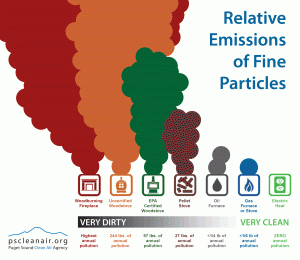Wood Smoke Pollution: A Personal Story
Families for Clean Air receives letters all the time from people suffering because someone nearby burns wood. Although it is important to publicize studies and statistics about wood smoke toxicity, we wanted to print this letter as a reminder that when someone burns, they are hurting their neighbors.
The letter reads:
“My neighbor, who lives in very close proximity to my house, has been burning wood in an indoor stove every “Spare the Air” [burn ban] day this season. He routinely burns at night, which is the most difficult for us. My daughter’s room, bathroom, and our living room are virtually uninhabitable due to smoke leakage into the house. I have taped all windows and doors adjacent to the neighbor, have 3 freestanding air filters going in those areas all the time and last year installed a house-wide air filtration system and new furnace ($12,000). I also push towels under some of the doors. I cannot keep this smoke out of my house, which is well-built, well-insulated, and has double-pane glass windows throughout.
I am an asthmatic and have no quality of life right now. I have had to increase my medications, and my last med bill was $1000, which will only take me until January. Sometimes, I awake with burning eyes, throat, and chest pains because the smoke is in my bedroom. Night before last, I awakened at 2:30 a.m. to a smoke-filled house and was up until the following night trying to clear the air. Once the smoke is in, it is almost impossible to get rid of it. Obviously, I cannot open any windows.
I would like to point out that this is not a case of a burning cigarette, it is a massive amount of wood, possibly not properly cured, polluting my home and endangering our health. We have been suffering for the entire 11 years that I have lived here. I have made numerous contacts with the neighbors, requesting them to comply with regulations, not to burn with opacity and not to burn on Spare-the-Air days. I also signed them up to receive the Spare-the-Air alerts…
I work at home so there is no respite. Any assistance in this matter would be greatly appreciated.”






